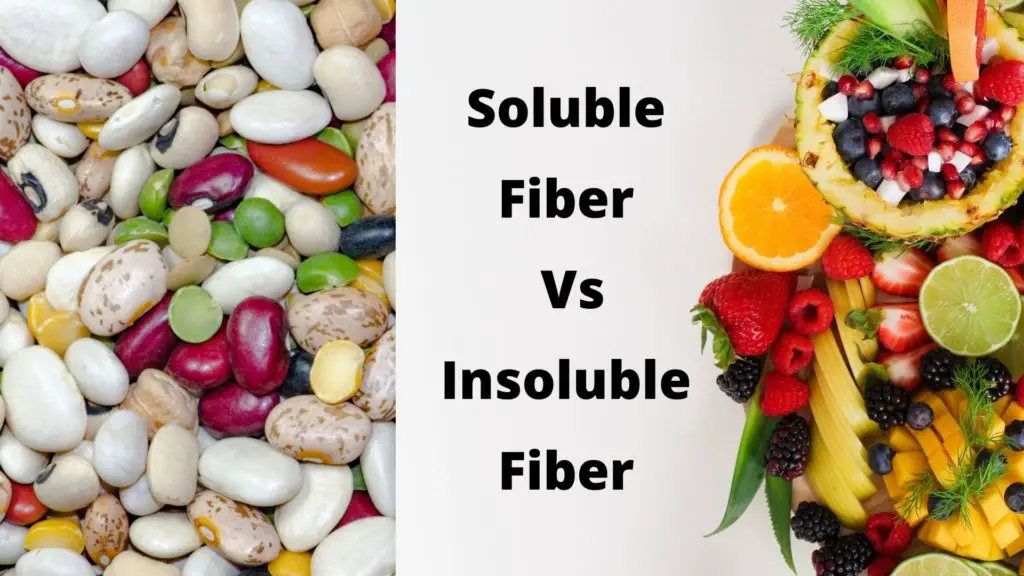The difference between soluble and insoluble fiber is in their roles. insoluble fiber catches excess sugar, and cholesterol, soluble fiber is our gut microbiota’s necessary fuel.
Fibre Soluble VS Fibre Insoluble
We can find both types of fiber in our food, however, there is often a predominance, that’s why they are separated into two different types.

The Insoluble fiber allows
- A feeling of satiety (and therefore’s against overeating)
- Capture the bad cholesterol
- Captures excess sugar (so it prevents cardiovascular disease and diabetes).
The soluble fiber
- Fermentation in the colon
- It improves the transit,
- Makes the balance of our Gut bacteria.
Many people are unaware of the importance of the bacteria in our colon, which proliferates due to the insoluble fiber.
What’s the intestinal microbiota?
It is Billions of bacteria that we need, which live in our gut. In fact, when this bacteria is in good condition (well fed) :
- It improves immunity (prevents colon cancer)
- It’s responsible for our psychological state throughout the day.
- Protects us from the risk of colon cancer and psychological disorders such as; depression, anxiety, stress, sleep disorders..etc.
Therefore, the consumption of both types of fiber, soluble and insoluble, is essential, but we must take into consideration some essential points in the composition.
Benefits and drawbacks
| Insoluble Fiber | Soluble Fiber |
Ferments in the colon by feeding the gut bacteria | More capacity for fermentation and contribution to the balance of these bacteria. |
Transforms into a viscous gel, and limits the absorption of nutrients including cholesterol and sugar (prevention of diabetes and cholesterol). | Not soluble in water, therefore it stays in the colon and start making gazes. |
Generally, foods rich in insoluble fiber (e.g. veggies) are rich in water and are low-carb foods. | Generally, foods rich in soluble fiber are dried ( low water and high carbs content such as legumes) |
| Helps in weight loss, because of its satiating effect (e.g. salad). | Some sources of soluble fiber (beans), have a high glycemic index and therefore are not effective in weight loss (if excess). |
| More protective role against high blood cholesterol levels and high blood sugar than the soluble fiber. | Protects against colon cancer due to their fermentation. |
| Promotes intestinal transit. | Promotes bowel health and regularity, and better intestinal transit. |
| – | May cause gas and bloating. |
As we have just seen in the table above, insoluble fiber can prevent cardiovascular disease while soluble fiber promotes good digestive health. It’s therefore recommended to consume both types of fiber at the same time, especially since they can be found in the same food.
What type of fiber is best for you?
In the case of irritable bowel
Irritable bowel syndrome can induce us to consume a particular type of fiber. Irritable bowel syndrome is characterized by stomach pain and cramps, bloating, diarrhea or constipation.

In this case, soluble fibers (whole wheat, wheat bran, and berries, among others) should be reduced because they stimulate intestinal contractions and can be irritating.
Foods known to cause gas and bloating, such as legumes and crucifers, should also be avoided. Otherwise, insoluble fiber should be favored, which can be found especially in fruits and vegetables.
But it’s preferable to avoid raw vegetables and to eat cooked ones, because the fibers, softened, become less irritating for the intestine.
cardiovascular diseases, or diabetes.
This is already mentioned in the table above, but it’s so important that I must repeat it. In the case of hypercholesterolemia (high cholesterol level in the blood), or diabetes (even to prevent type 2 diabetes in case of family history), I recommend you eat mostly insoluble fiber.
They have the particularity of resisting against liquids. When consumed, they form a gel that lines the wall of the colon. “This viscous substance will thus reduce the absorption of fats, and cholesterol and also reduce the risks of high blood sugar which is important to prevent type 2 diabetes
Which fiber is best for weight loss?
Insoluble fiber slows down the progression of food in the stomach, limits food intake and contributes to the feeling of satiety. They, therefore, prevent weight gain.
Most foods rich in insoluble fiber, bring in parallel water and so many mineral salts which take part in the feeling of satiety.
Soluble fiber for psychological disorders
The soluble fiber as I always say is prebiotics, that’s to say, the intestinal bacteria (important for our moral and physical health).
It feeds on the soluble fiber by fermenting it so that this bacteria can multiply, grow, and have a good balance in our intestinal flora. This flora when it’s good, we’re good ( better mental health). And that’s why we say that the gut is our second brain because they’re both linked.
Many teams are testing the relationship between dietary fiber intake and depression, in an attempt to reduce the risk of depression.
This study contributes to this research effort by identifying, through analysis of data from 5,800 women of various ages, a significant, inverse relationship between dietary fiber intake and the incidence of depression.
Sources of Dietary fiber
Dietary fiber, mainly found in fruits, vegetables, whole grains and legumes, has already been shown to have mental health benefits.
But something is sure, that fiber improves the richness and diversity of the gut microbiota, but (the observational study also suggests a link between dietary fiber intake and depression), fiber intake may help improve brain health by modulating the gut microbiome.
Let’s wrap it up!
In a very simple way, we understand that soluble and insoluble fibers, when crossing the digestive tract, behave differently.
Soluble or insoluble, fiber has significant effects on digestion, glycemia, satiety and carbohydrate metabolism. If you are not used to consume fiber, gradually increase the amount in your diet. Excessive fiber intake can lead to unpleasant digestive problems.
Fiber cannot be taken out of the diet at any age. Fortunately, soluble and insoluble fibers are readily available and come in a wide variety.